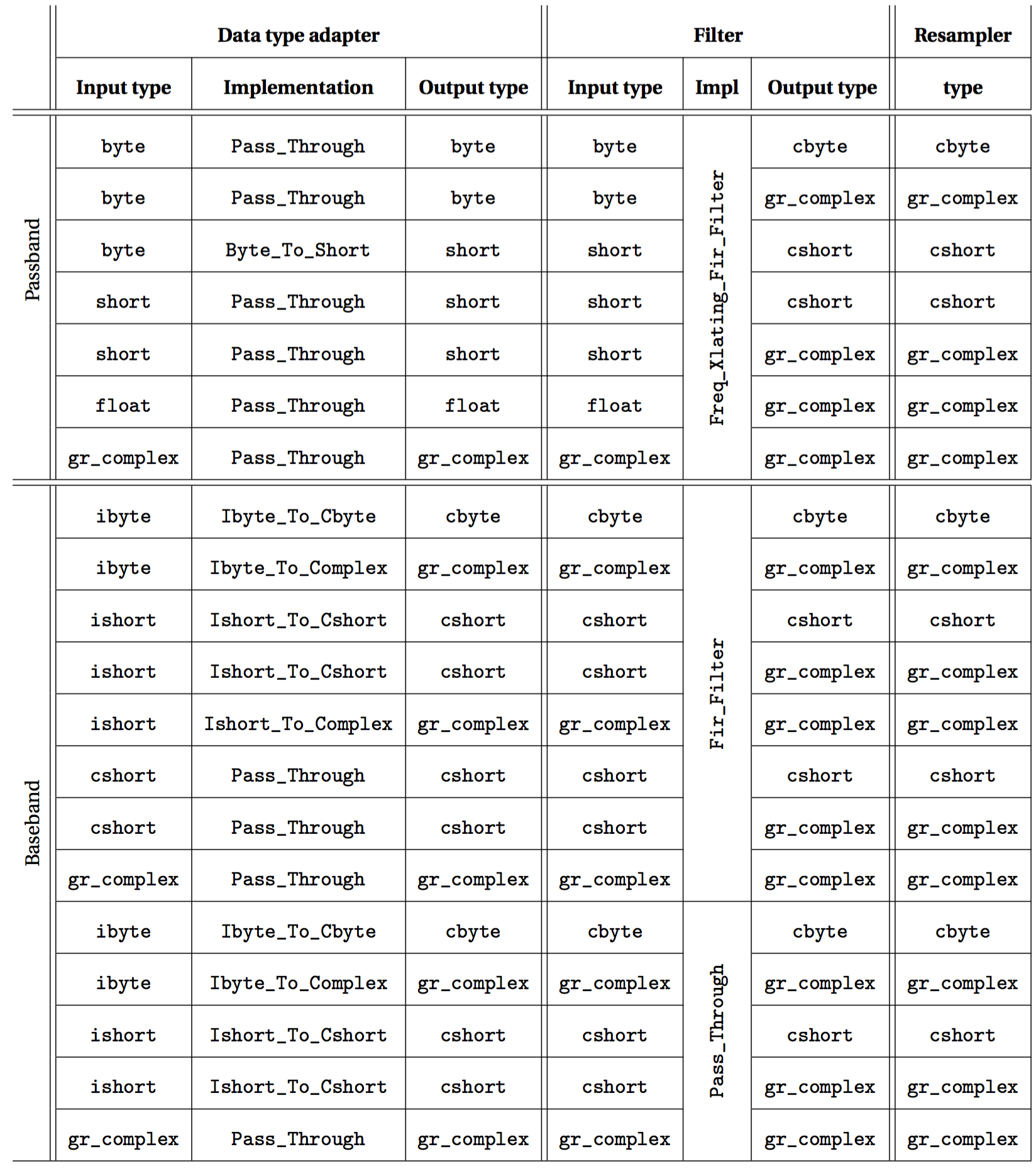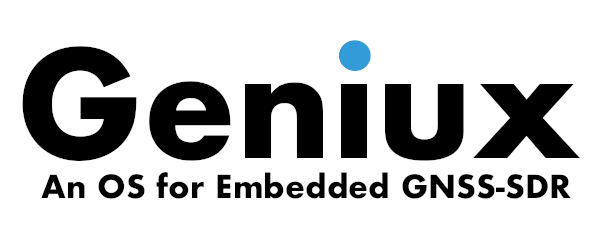Understanding Data Types
Data ingestion in GNSS-SDR
The inputs of a software receiver are the raw bits that come out from the front-end’s analog-to-digital converter (ADC), as shown below. Those bits can be read from a file stored in the hard disk or directly in real-time from a hardware device through USB or Ethernet buses.

This is a simplified block diagram of a generic radio frequency front-end, consisting of an antenna, an amplification stage, downshifting from RF to an intermediate frequency, filtering, sampling, and an interface to a host computer for real-time processing mode, or to a storage device for post-processing.
GNSS-SDR is designed to work with a wide range of radiofrequency front-ends, each one with its own parameters for the sampling frequency, number of bits per sample, signal format (baseband or passband), etc. When the sample stream enters the host computer, there is a first processing block, called Signal Conditioner, which is in charge of accommodating the sample stream in a format tractable by a computer. The containers of data in a computer system are called data types.
Data type definition
A type is a set of possible values that an object, reference, function, or expression can possess, and it is defined as its representation and a set of operators manipulating these representations. The type is a property that both restricts the operations that are permitted for those entities and provides semantic meaning to the otherwise generic sequences of bits.
Fundamental data types in C++
The C++ type system defines the following fundamental types:
- The type
voidspecifies that the function does not return a value. - The null-pointer type
std::nullptr_t - Arithmetic types:
- Floating-point types (
float,double,long double) - Integral types
- The type
bool - Character types
- Narrow character types (
char,signed char,unsigned char) - Wide character types (
char16_t,char32_t,wchar_t)
- Narrow character types (
- Signed integer types (
short,int,long,long long) - Unsigned integer types (
unsigned short,unsigned int,unsigned long,unsigned long long)
- The type
- Floating-point types (
The following Table lists the fundamental data types in C++. Within each of the
groups, the difference between types is only their size (i.e., how much they
occupy in memory): the first type in each group is the smallest, and the last is
the largest, with each type being at least as large as the one preceding it in
the same group. Other than that, the types in a group have the same properties.
The names of certain integer types can be abbreviated without their signed and
int components - only the part not in italics is required to identify the type,
the part in italics is optional. I.e., signed short int can be abbreviated as
signed short, short int, or simply short; they all identify the same
fundamental type.
| Group | Type names | Notes on size / precision |
|---|---|---|
| Void type | void | no storage |
| Null pointer | decltype(nullptr) | |
| Boolean type | bool | |
| Character types | char | Exactly one byte in size. At least 8 bits. |
| char16_t | Not smaller than char. At least 16 bits. | |
| char32_t | Not smaller than char16_t. At least 32 bits. | |
| wchar_t | Can represent the largest supported character set. | |
| signed char | Same size as char. At least 8 bits. | |
| Integer types (signed) | signed short int | Not smaller than char. At least 16 bits. |
| signed int | Not smaller than short. At least 16 bits. | |
| signed long int | Not smaller than int. At least 32 bits. | |
| signed long long int | Not smaller than long. At least 64 bits. | |
| Integer types (unsigned) | unsigned char | Exactly one byte in size. At least 8 bits. |
| unsigned short int | Not smaller than char. At least 16 bits. | |
| unsigned int | Not smaller than short. At least 16 bits. | |
| unsigned long int | Not smaller than int. At least 32 bits. | |
| unsigned long long int | Not smaller than long. At least 64 bits. | |
| Floating-point types | float | |
| double | Precision not less than float | |
| long double | Precision not less than double |
Note that other than char (which has a size of exactly one byte), none of the
fundamental types has a standard size specified (but a minimum size, at most).
Therefore, the type is not required (and in many cases is not) exactly this
minimum size. This does not mean that these types are of undetermined size, but
that there is no standard size across all compilers and machines; each compiler
implementation may specify the sizes for these types that fit the best the
architecture where the program is going to run.
In C++, the typedef keyword allows the programmer to create new names for
types, as shown below:
// simple typedef
typedef unsigned long ulong;
// the following two objects have the same type
unsigned long l1;
ulong l2;
Idea to take home: If your GNSS front-end is delivering samples of 2-bit length, a computer does not know how to handle them. A data type for that length is not defined, so there are no operations defined upon it. Even if you define a specific data type and its related operations, processors and compilers will likely not be optimized for such a non-standard type. You need to bring whatever format your Signal Source is delivering to a format that is understandable by the processing environment (processor, operating system, compiler, etc.) in charge of executing GNSS-SDR. Luckily, it is easy to define new formats converters, and they need to be placed at the first processing block that receives the incoming sample stream: the Data Type_Adapter.
Data types in GNSS-SDR
In the C and C++ programming languages,
stdint.h
(or its cstdint
counterpart for C++) is the name of the header file that allows programmers to
write more portable code by providing a set of typedefs that specify exact-width
integer types, together with the defined minimum and maximum allowable values
for each type. This header is particularly useful for embedded programming which
often involves considerable manipulation of hardware-specific I/O registers
requiring integer data of fixed widths, specific locations and exact alignments.
The naming convention for exact-width integer types is intN_t for signed int
and uintN_t for unsigned int. Among others, both
stdint.h
and cstdint define the
following typedefs:
-
int8_tSigned integer type with a width of exactly 8 bits. -
int16_tSigned integer type with a width of exactly 16 bits. -
int32_tSigned integer type with a width of exactly 32 bits.
Building upon these definitions, the Vector-Optimized Library of Kernels
(VOLK) library defines complex data types. As shown
below, it loads the header
<complex>, a file that
defines functionality for complex arithmetic (i.e. basic, arithmetic,
trigonometric and hyperbolic operations, but only for floating-point data types:
float, double and long double. This means that complex operations are not
defined for integer data types, and, for instance, the instantiation of an
object of type std::complex<int8_t> has undefined behavior. The VOLK library
provides definitions for those data types that are missing in C++ in a portable
manner.
Those data type definitions can be seen at volk/include/volk/volk_complex.h. We reproduce here a snippet to make those definitions more obvious:
...
#include <complex>
#include <stdint.h>
...
typedef std::complex<int8_t> lv_8sc_t;
typedef std::complex<int16_t> lv_16sc_t;
typedef std::complex<int32_t> lv_32sc_t;
typedef std::complex<int64_t> lv_64sc_t;
typedef std::complex<float> lv_32fc_t;
typedef std::complex<double> lv_64fc_t;
template <typename T> inline std::complex<T> lv_cmake(const T &r, const T &i){
return std::complex<T>(r, i);
}
...
As shown in the typedefs listed above, VOLK defines type names for objects holding complex numbers in which their real and imaginary parts are integers of exactly 8, 16, 32, or 64 bits, or floating-point numbers of 32 or 64 bits. It also provides a template constructor for them.
Internally, GNSS-SDR makes use of the complex data types defined by VOLK. They are fundamental for handling sample streams in which samples are complex numbers with real and imaginary components of 8, 16 or 32 bits, common formats delivered by GNSS radio frequency front-ends. The next Table shows the data type names that GNSS-SDR exposes through the configuration file.
| Type name in GNSS-SDR conf files | Identifier in VOLK kernels | Definition | Sample stream |
|---|---|---|---|
| byte | 8i | Signed integer, 8-bit two’s complement number ranging from -128 to 127. C++ type name: int8_t |
\([ S_0 ], [S_1 ], [S_2], ...\) |
| short | 16i | Signed integer, 16-bit two’s complement number ranging from -32768 to 32767. C++ type name: int16_t |
\([ S_0 ], [S_1 ], [S_2], ...\) |
| float | 32f | Defines numbers with fractional parts, can represent values ranging from approx. \(1.5 \times 10^{-45}\) to \(3.4 \times 10^{38}\) with a precision of 7 digits (32 bits). C++ type name: float |
\([ S_0 ], [S_1 ], [S_2], ...\) |
| ibyte | 8i | Interleaved (I&Q) stream of samples of type byte. C++ type name: int8_t |
\([ S_0^{I} ], [ S_0^{Q} ], [S_1^{I} ], [S_1^{Q}], [ S_2^{I} ], [S_2^{Q}], ...\) |
| ishort | 16i | Interleaved (I&Q) samples of type short. C++ type name: int16_t |
\([ S_0^{I} ], [ S_0^{Q} ], [S_1^{I} ], [S_1^{Q}], [ S_2^{I} ], [S_2^{Q}], ...\) |
| cbyte | 8ic | Complex samples, with real and imaginary parts of type byte. C++ type name: lv_8sc_t |
\([S_0^{I}+jS_0^{Q}],[S_1^{I}+jS_1^{Q}],[S_2^{I}+jS_2^{Q}],...\) |
| cshort | 16ic | Complex samples, with real and imaginary parts of type short. C++ type name: lv_16sc_t |
\([S_0^{I}+jS_0^{Q}],[S_1^{I}+jS_1^{Q}],[S_2^{I}+jS_2^{Q}],...\) |
| gr_complex | 32fc | Complex samples, with real and imaginary parts of type float. C++ type name: std::complex<float> |
\([S_0^{I}+jS_0^{Q}],[S_1^{I}+jS_1^{Q}],[S_2^{I}+jS_2^{Q}],...\) |
From the Signal Source to the processing Channels
A Signal Conditioner block is in charge of adapting the sample bit depth to a data type tractable at the host computer running the software receiver, and optionally intermediate frequency to baseband conversion, resampling, and filtering. Regardless of the selected signal source features, the Signal Conditioner interface delivers in a unified format a sample data stream to the receiver downstream processing channels, acting as a facade between the signal source and the synchronization channels, providing a simplified interface to the input signal at a reference, internal sample rate. This signal stream feeds a set of parallel Channels.

This is an example of Signal Conditioner configuration, in which the Signal
Source is delivering samples of type ishort. We convert them to gr_complex
with the Data Type Adapter, and then all the downstream processing (filtering
and resampling) is also performed on gr_complex data. Hence, in this example
the data stream delivered to Channels is of type gr_complex:
; ...
;######### SIGNAL_CONDITIONER CONFIG ############
; It holds blocks to change data type, filter and resample input data.
; Can be by-passed by setting its implementation to Pass_Through
SignalConditioner.implementation=Signal_Conditioner
;######### DATA_TYPE_ADAPTER CONFIG ############
; Changes the type of input data.
; implementation: Pass_Through by-passes this block
DataTypeAdapter.implementation=Ishort_To_Complex
;######### INPUT_FILTER CONFIG ############
; Filters the input data.
; implementation: Pass_Through by-passes this block
InputFilter.implementation=Fir_Filter
InputFilter.input_item_type=gr_complex
InputFilter.output_item_type=gr_complex
; ... other parameters
;######### RESAMPLER CONFIG ############
; Resamples the input data.
; implementation: Pass_Through by-passes this block
Resampler.implementation=Direct_Resampler
Resampler.item_type=gr_complex
Resampler.sample_freq_in=8000000
Resampler.sample_freq_out=4000000
; ...
The data type expected by Channels actually depends on the specific
implementations chosen for Acquisition and Tracking blocks. Currently, all
the available implementations admit gr_complex at its input, and some of them
also cshort. But maybe in the future there will be other implementations
working with cbyte, so there is a need for flexibility when bringing the data
stream from Signal Source to the Channels. The following guidelines could
help you to choose the right path for your setup:
-
In a processing flow graph, the data type used by a processing block to write at its output buffer(s) must be the same as the downstream processing blocks which are consuming data from its input buffer(s). Please check that the implementation of the immediately next processing nodes accepts that specific output data format.
-
The less processing, the faster. If your Signal Source already delivers samples in a format that Channels admits, setting
SignalConditioner.implementation=Pass_Through(that is, a direct wire between the Signal Source and Channels) is probably the best choice. Unnecessary filtering or data format conversion will always consume processing cycles, and given that those operations are performed at the sample rate provided by the signal source, this is especially critical if you are working with a real-time configuration. If you are reading samples from a file, there is no more constraint here than the required processing time. -
In general, the smaller the data type, the faster. Intuitively, the fewer bits the processor needs to operate with, the faster it can perform the given instruction. That is, multiplying a pair of 8-bit integers should be faster than multiplying a pair of 32-bit floating-point values. However, in practice this not always holds. Processor manufacturers have spent a lot of effort in optimizing floating-point operations and, when combined with the inherent saturation problem in integer arithmetics (which proper management use to consume a non-negligible amount of cycles), it turns out that sometimes a floating-point operation can be done as fast as its 8 or 16-bit integer counterpart, or even faster. We have found widely different results when using different computing platforms, so specific testing in your machine is always recommended.
-
If your Signal Source is delivering a format that is not defined in the Table above (for instance, a specific mapping of signed samples of 2-bit length, which is usual in GNSS-specific front-ends, or any other combination), you need a specific Data Type Adapter for such format.
-
If your Signal Source is delivering signal at some Intermediate Frequency instead of baseband, use the
Freq_Xlating_Fir_Filterimplementation for Filter and bring it down to a baseband signal (i.e., complex format).
The following Table shows some of the possible configurations when bringing samples from your Signal Source to the processing Channels:

What happens after Channels?
Your duty as a user when configuring GNSS-SDR, in matters related to data types, ends when delivering samples to Channels. After that, all the information is handled by an object of an internal class (check out its API if you are curious) and the results of the whole processing are then delivered in standard formats such as RINEX, RTCM 104, or KML, among others.




Leave a comment